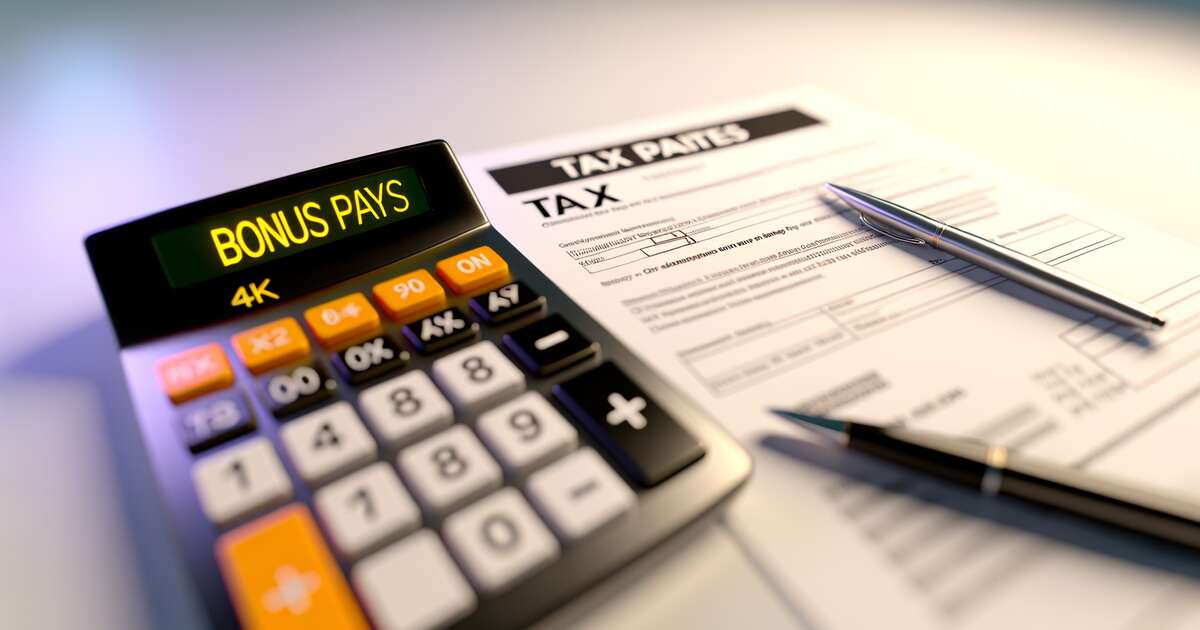
Tackling the maze of Bonus Pay Tax Rates doesn’t have to be daunting! Whether it’s a reward for outstanding performance or a year-end thank you from your employer, understanding how your bonus money gets taxed is crucial. But how do you navigate these waters without feeling overwhelmed?
This guide breaks down the complexities of Bonus Pay Tax Rates into simple, digestible steps. Who knew that with the right information, you could become a whiz at figuring out your tax obligations? It’s time to get your calculator ready and dive into the world of taxes with confidence and ease. 😎
Understanding Bonus Pay: Definitions and Examples
Before diving into the complex calculations of bonus pay tax rates, understanding what bonus pay encompasses is crucial. What comes to your mind when you think of bonuses? Most people dream of hefty year-end rewards or performance incentives. However, the reality is that bonus pay can include a variety of payment types beyond just a performance bonus. 🌟
Definition of Bonus Pay: Bonus pay refers to compensation awarded to employees over and above their regular earnings. This can be structured in several forms, including year-end bonuses, profit-sharing, commission bonuses, or other performance-related incentives that companies use to motivate and reward employees.
Examples of Bonus Pay
- Year-end bonuses: Typically given at the end of the business year
- Sales commissions: Earned based on the sales an employee generates
- Performance bonuses: Rewarded for meeting or exceeding specific job performance criteria
- Signing bonuses: Offered to new employees as an incentive to join a company
Understanding these different types of bonuses is vital as each can have different tax implications. Why is this important? Because knowing how to handle Bonus Pay Tax Rates effectively ensures compliance and accuracy in payroll management—critical aspects for both the employer and the employee. 📈

Exploring the Different Methods to Calculate Taxes on Bonuses
When it comes to handling Bonus Pay Tax Rates, knowing the different methods to calculate taxes on bonuses is crucial. But why is it so important, and how can it affect your finances? Understanding these methods not only helps in compliance but also ensures you are not overpaying or underpaying your taxes.
The Percentage Method
One common approach is the Percentage Method. This straightforward method applies a flat percentage rate to the bonus amount. It’s generally quick and easy — but does it always work out to be the most beneficial? That depends on several factors, including the size of the bonus and your overall tax bracket.
The Aggregate Method
Alternatively, there’s the Aggregate Method, which might seem a bit more complex. In this approach, the bonus is combined with an employee’s most recent regular paycheck. The total is then used to determine the amount of withholding tax using the standard IRS tax tables. Wondering if this could lead to higher tax savings? It could, especially if your regular income varies or if you have multiple additional income sources.
Deciding which method to use often depends on the specific circumstances surrounding your bonus and your financial goals. Have you considered how these methods might impact your take-home pay? Consulting with a tax professional or using specialized tax calculation tools can provide clarity and ensure you make the best decision based on your personal financial situation.
Step-by-Step Guide to Using the Percentage Method
Calculating Bonus Pay Tax Rates using the percentage method can be a breeze if you follow these straightforward steps. Not only is it efficient, but it also ensures that you’re compliant with tax regulations. Are you ready to tackle the math and keep your finances in check?
Step 1: Determine the Total Bonus Amount
Begin by calculating the total amount of the bonus that needs to be taxed. It’s crucial to get this number right to ensure accurate tax calculations.
Step 2: Apply the Flat Percentage Rate
Once you have the total bonus amount, apply the standard flat tax rate for bonuses. Typically, this rate is set by the IRS and, as of recent guidelines, stands at 22%. Isn’t it simple to just apply a flat rate?
Step 3: Calculate the Tax Due
Multiply the total bonus amount by the percentage rate to find out how much tax is due. For example, if a $1,000 bonus is awarded, the tax due would be $220 (1,000 x 0.22). This method eliminates any complicated math, making your tax calculations straightforward and stress-free.

Applying the Aggregate Method for Bonus Tax Calculations
When it comes to determining the Bonus Pay Tax Rates using the aggregate method, the process can seem complex, but it’s quite manageable once you break it down. This method involves adding the bonus amount to the employee’s most recent regular paycheck to calculate the total amount of taxes due. Why is this useful? Because it leverages the existing tax rates of the employee’s regular income, providing a more comprehensive tax calculation.
First, you’ll need to sum the bonus with the latest paycheck amount. Next, using this total, apply the standard tax withholding rates that would typically apply to a paycheck of this new, higher amount. The result? The tax for the entire amount is calculated, and then the tax already withheld from the last paycheck is subtracted. What you’re left with is the tax amount due on the bonus itself.
Advantages of the Aggregate Method
One of the standout benefits of the aggregate method is its accuracy in tax calculation for employees who have variable pay scales or who receive significantly large bonuses. It adjusts the tax withholdings to more accurately reflect the employee’s tax bracket, potentially avoiding underpayment or overpayment scenarios. But, how does this work in your favor during tax season? 🤔
- Ensures accurate tax withholdings based on true earnings.
- Helps in better tax planning and financial management for employees.
- Prevents possible IRS penalties for underpayment of taxes on large bonuses.
Common Mistakes to Avoid When Calculating Bonus Taxes
Getting your calculations right when handling Bonus Pay Tax Rates can be tricky. However, being aware of common pitfalls beforehand can save you headaches down the line. In this section, we’ll go over several mistakes that you should avoid to ensure that your calculations are spot-on. Are you ready to become a pro at navigating bonus taxations?
Avoiding Miscalculations: What Not to Do
- Not updating the tax tables or software you use for calculations, which can lead to outdated results.
- Ignoring the specific statutory provisions applicable to bonuses. Each state might have variations in how bonuses are taxed.
- Overlooking employee classifications that might impact the applicable tax rules. Did you know different rules could apply depending on the employee’s tax bracket or job role?
Moreover, another critical oversight is failing to double-check your calculations. Errors can be costly both financially and in terms of regulatory compliance. Always ensure that your data input is accurate and that you’re applying the correct calculations method, whether it’s the Percentage Method or the Aggregate Method.
Lastly, underestimating the impact of local taxes on bonus payments is a common error. Local taxes can significantly affect the net amount an employee receives, so it’s vital to stay informed about local tax obligations. Are you keeping an eye on all these details when crunching those numbers?
Common Questions
Are bonuses taxed at 40%?
Bonuses are not universally taxed at 40%. In the United States, the federal tax rate for bonuses can be calculated in different ways, typically either through the percentage method or the aggregate method. Under the percentage method, bonuses are often subject to a flat rate, commonly 22%, though for larger bonus amounts, IRS guidelines may require withholding at a higher rate, up to 37%. State taxes may apply as well. Therefore, the effective tax rate on bonuses might vary, and the 40% assumption may only occur in specific scenarios where federal and state taxes combine to reach that level.
Why is my bonus taxed at 35 percent?
Your bonus might be taxed at a 35 percent rate due to several factors, including the specific tax policies of your state and the federal guidelines on supplemental wages. Federally, the IRS typically taxes bonuses through two methods: the percentage method and the aggregate method. By the percentage method, bonuses are taxed at a flat rate of 22%. However, if your bonus and regular wages are combined, and then taxes are withheld based on the usual tax brackets in the aggregate method, you might see a higher taxation rate such as 35% depending on your total income bracket. Additionally, the inclusion of state taxes might push the total tax rate on your bonus to 35%.
Why is my commission taxed at 40%?
Commissions are taxed similarly to bonuses, viewed as supplemental wages by the IRS. The high taxation rate like 40% could arise if your commission is added to your regular wages and the total amount places you in a higher tax bracket. The IRS uses two primary methods to tax commissions: the percentage method, where a flat rate commonly at 22% is applied directly to the commission, and the aggregate method, where commissions are added to regular income and taxed at your corresponding income tax rate. If using the aggregate method, the combined income could potentially be subjected to higher tax rates, especially if it crosses into a higher tax bracket. Additionally, state and local taxes can further increase the effective tax rate on commissions to reach or exceed 40%.
What is the federal tax rate for bonuses in 2024?
As of now, the federal tax guidelines for taxing bonuses in 2024 remain consistent with previous years unless new tax legislation is introduced. Bonuses are considered supplemental wages and the IRS generally taxes them using two methods: the percentage method, which typically involves a flat rate of 22%, and the aggregate method, where the bonus is added to an employee’s regular income and taxed at their marginal tax rate. However, no specific changes to these rates or methods have been announced for 2024 as of the latest available information.
Tips and Tools to Simplify Your Bonus Tax Calculations
Navigating through the maze of tax calculations can be daunting, especially when it comes to specific items like bonuses. But don’t worry, a variety of tips and tools are available to make your computation of Bonus Pay Tax Rates a breeze! 🌬️
Key Tips for Easier Bonus Pay Tax Calculations
- Always keep updated on the latest tax brackets and rates as these can change yearly and impact how bonuses are taxed.
- Ensure you have accurate and up-to-date payroll records. This will simplify your calculations and help avoid errors.
Essential Tools for Accurate Calculations
There are several online calculators and software that are specifically designed for tax calculations, including those for bonuses. These tools often include features that handle complex calculations automatically, making your life much easier. Why struggle with spreadsheets when these tools can do the heavy lifting for you?
For instance, using an online bonus pay tax calculator can help you apply the correct tax rates and methods swiftly and correctly. Have you already tried using one in your calculations?
Final Thoughts: How to Calculate Bonus Pay Tax Rates with Ease?
Navigating the complexities of Bonus Pay Tax Rates doesn’t have to be a daunting task. With the methods and tips we’ve explored today, you’re well on your way to mastering the art of accurately calculating bonus taxes. Remember, getting these calculations right means staying compliant and avoiding potential financial hiccups. Isn’t it great to feel confident about handling these matters with ease?
As you continue to apply these straightforward methods—whether the percentage method or the aggregate method—always double-check your work and utilize the tools we discussed to ensure accuracy. By doing so, you’ll minimize errors and make the most out of your bonus earnings. Ready to tackle your next bonus tax calculation with confidence?





